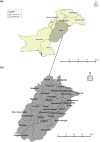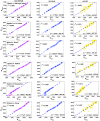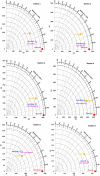Coupled online sequential extreme learning machine model with ant colony optimization algorithm for wheat yield prediction
- PMID: 35361838
- PMCID: PMC8971467
- DOI: 10.1038/s41598-022-09482-5
Coupled online sequential extreme learning machine model with ant colony optimization algorithm for wheat yield prediction
Abstract
Inadequate agricultural planning compounded by inaccurate predictions results in an inflated local market rate and prompts higher importation of wheat. To tackle this problem, this research has designed two-phase universal machine learning (ML) model to predict wheat yield (Wpred), utilizing 27 agricultural counties' data within the Agro-ecological zone. The universal model, online sequential extreme learning machines coupled with ant colony optimization (ACO-OSELM) is developed, by incorporating the significant annual yield data lagged at (t - 1) as the model's predictor to generate future yield at 6 test stations. In the first phase, ACO is adopted to search for suitable, statistically relevant data stations for model training, and the corresponding test station by virtue of a feature selection strategy. An annual wheat yield time-series input dataset is constructed utilizing data from each selected training station (1981-2013) and applied against 6 test stations (with each case modelled with 26 station data as the input) to evaluate the hybrid ACO-OSELM model. The partial autocorrelation function is implemented to deduce statistically significant lagged data, and OSELM is applied to generate Wpred. The two-phase hybrid ACO-OSELM model is tested within the 6 agricultural districts (represented as stations) of Punjab province, Pakistan and the results are benchmarked with extreme learning machine (ELM) and random forest (RF) integrated with ACO (i.e., hybrid ACO-ELM and hybrid ACO-RF models, respectively). The performance of the ACO-OSELM model was proven to be good in comparison to ACO-ELM and ACO-RF models. The hybrid ACO-OSELM model revealed its potential to be implemented as a decision-making system for crop yield prediction in areas where a significant association with the historical agricultural crop is well-established.
© 2022. The Author(s).
Conflict of interest statement
The authors declare no competing interests.
Figures











References
-
- Martin G, Martin-Clouaire R, Duru M. Farming system design to feed the changing world. A review. Agron. Sustain. Dev. 2013;33:131–149.
-
- McElwee G, Bosworth G. Exploring the strategic skills of farmers across a typology of farm diversification approaches. J. Farm Manag. 2010;13:819–838.
-
- Maghrebi M, et al. Iran’s agriculture in the anthropocene. Earth’s Future. 2020 doi: 10.1029/2020EF001547. - DOI
-
- Raorane AA, Kulkarni RV. Data mining: An effective tool for yield estimation in the agricultural sector. Int. J. Emerg. Trends Technol. Comput. Sci. 2012;1:1–4.
MeSH terms
LinkOut - more resources
Full Text Sources

